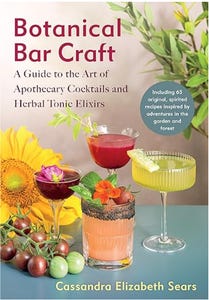Book review: Botanical Bar Craft
A Guide to the Art of Apothecary Cocktails and Herbal Tonic Elixirs, Author: Cassandra Elizebeth Sears
These days there seems to be a renewed interest in cocktails and tonics, especially those that are made with unusual ingredients. It seems that people are looking for a different twist to the standard drinks menu when gathering with friends or enjoying a special beverage by oneself. In Botanical Bar Craft: A Guide to the Art of Apothecary Cocktails and Herbal Tonic Elixirs the author, Cassandra Elizabeth Sears, brings together a very unique set of skills, being both an herbalist and a mixologist, to create both alcoholic and non-alcoholic drinks that celebrate the healing power of plants.
The opening chapters of the book are a wonderful education all by themselves. They cover the historical role of botanicals in ancestral medicine and spirits, the fundamentals of botanical bar craft, and an overview of how herbs interact with the body. There's also a fascinating exploration of herbal chemistry, distillation methods, and even a behind-the-scenes look at several New England distilleries. For anyone who wants to create garden-to-glass concoctions, Sears includes a chapter about creating your own herbal garden—from planting to harvesting.
One of the wonderful things about this book is how the recipes follow the rhythm of the seasons, drawing inspiration from what’s growing and blooming. The recipes are creative and inviting, often labeled with the actions of the herbs used giving readers a deeper sense of how each drink can nourish both body and spirit. Some recipes focus on flavorful components, like the Rosemary-Infused Olive Oil (page 141) for the Tuscan Garden cocktail, or the Blueberry-Chaga Elixir (page 178), which is part of the sweetly named Babe in the Woods cocktail. In addition to being cocktail components, these elixirs, syrups, and infusions could easily stand alone in teas, spritzers, or other creative concoctions.
Visually, the book is a treat, featuring gorgeous photography and lovely line drawings that complement the ingredients and the drinks. The final chapter, a collection of plant monographs, serves as a helpful reference for anyone wishing to deepen their herbal knowledge.
Many of the preparations do call for patience, after all it takes time to brew a tincture or an infusion, and yet this book is a rewarding journey into the art of intentionally creating functional and nourishing botanical beverages. It’s a perfect starting point (or next step) for those seeking drinks with depth, wellness, and soul.
For anyone who wants to connect more deeply with plants while creating shared or solitary sips, Botanical Bar Craft is an inspiring addition to your bookshelf.




